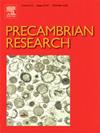Crustal reworking during the transition of tectonic regime in the Paleoproterozoic Era: Constraints from geochemistry, Sm-Nd isotope and U-Pb geochronology of granitic gneisses, Dudhi Granitoid Complex, Mahakoshal belt, Central Indian Tectonic Zone (CITZ), India
IF 3.2
2区 地球科学
Q2 GEOSCIENCES, MULTIDISCIPLINARY
引用次数: 0
Abstract
The Paleoproterozoic Dudhi Granitoid Complex is composed of numerous granitoid intrusions and gneissic components that is located in the Mahakoshal belt, which is an important supracrustal belt of the Central Indian Tectonic Zone (CITZ) and played a vital role in the crustal accretion of the Columbia supercontinent. Thus, we present new geochemical data, Sm-Nd isotope analyses, and U-Pb geochronology of the granitic gneisses from the Dudhi Granitoid Complex to understand their origin, evolution and tectonic setting. The LA-ICP-MS zircon U-Pb dating yields ages of 1707.9 ± 7.4 Ma, 1724.3 ± 8.6 Ma, 1736.8 ± 9.9 Ma, 1748.3 ± 7.9 Ma, and 1756.3 ± 10 Ma for studied granitic gneisses. These rocks are strongly metaluminous and show enrichment in high field strength elements (HFSE) and depletion in large ion lithophile elements (LILE). The trace element composition allows classifying these rocks as an A2-type affinity in an extensional environment. They show negative values of ɛNd(t) (−5.7 to −0.4) and old Nd-model ages (TDM: 2068–2420) support their crustal origin. Geochemical and Nd isotope data indicate that they were derived by partial melting of older granites and granitic gneisses crust i.e., Archean Bundelkhand crust and Paleoproterozoic (>1.9 Ga) juvenile crustal basement of the Mahakoshal basin. Finally, their magmatism during 1.75–1.70 Ga is linked to the transition period of accretion and dispersal of the Columbia supercontinent, which is incorporated into the lithosphere of the CITZ.
古元古代构造体制转变时期的地壳改造:来自印度中部构造带Dudhi花岗质杂岩地球化学、Sm-Nd同位素和U-Pb年代学的约束
古元古代Dudhi花岗杂岩是由大量花岗岩体和片麻岩组成的,位于印度中部构造带(CITZ)重要的上地壳带Mahakoshal带,在哥伦比亚超大陆的地壳增生中发挥了重要作用。为此,我们对杜迪花岗杂岩的花岗质片麻岩进行了新的地球化学数据、Sm-Nd同位素分析和U-Pb年代学研究,以了解其起源、演化和构造背景。LA-ICP-MS锆石U-Pb测年结果显示,花岗岩片麻岩年龄分别为1707.9±7.4 Ma、1724.3±8.6 Ma、1736.8±9.9 Ma、1748.3±7.9 Ma和1756.3±10 Ma。这些岩石具有强成矿性质,富高场强元素(HFSE),富大离子亲石元素(LILE)。微量元素组成可将这些岩石划分为伸展环境中的a2型亲和岩。它们的Nd(t)值为负值(−5.7 ~−0.4),且古老的Nd模式年龄(TDM: 2068 ~ 2420)支持它们的地壳起源。地球化学和Nd同位素数据表明,它们是由古花岗岩和花岗质片麻岩地壳(太古宙Bundelkhand地壳和Mahakoshal盆地古元古代(>1.9 Ga)幼代地壳基底的部分熔融作用形成的。1.75 ~ 1.70 Ga时期的岩浆活动与哥伦比亚超大陆的吸散过渡时期有关,该超大陆已并入CITZ岩石圈。
本文章由计算机程序翻译,如有差异,请以英文原文为准。
求助全文
约1分钟内获得全文
求助全文
来源期刊

Precambrian Research
地学-地球科学综合
CiteScore
7.20
自引率
28.90%
发文量
325
审稿时长
12 months
期刊介绍:
Precambrian Research publishes studies on all aspects of the early stages of the composition, structure and evolution of the Earth and its planetary neighbours. With a focus on process-oriented and comparative studies, it covers, but is not restricted to, subjects such as:
(1) Chemical, biological, biochemical and cosmochemical evolution; the origin of life; the evolution of the oceans and atmosphere; the early fossil record; palaeobiology;
(2) Geochronology and isotope and elemental geochemistry;
(3) Precambrian mineral deposits;
(4) Geophysical aspects of the early Earth and Precambrian terrains;
(5) Nature, formation and evolution of the Precambrian lithosphere and mantle including magmatic, depositional, metamorphic and tectonic processes.
In addition, the editors particularly welcome integrated process-oriented studies that involve a combination of the above fields and comparative studies that demonstrate the effect of Precambrian evolution on Phanerozoic earth system processes.
Regional and localised studies of Precambrian phenomena are considered appropriate only when the detail and quality allow illustration of a wider process, or when significant gaps in basic knowledge of a particular area can be filled.
 求助内容:
求助内容: 应助结果提醒方式:
应助结果提醒方式:


